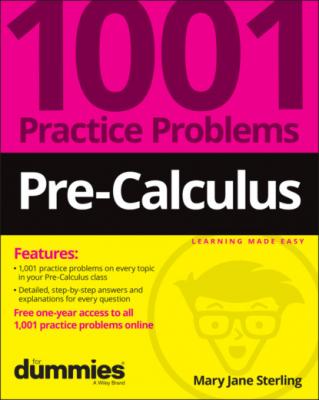ТОП просматриваемых книг сайта:
Pre-Calculus: 1001 Practice Problems For Dummies (+ Free Online Practice). Mary Jane Sterling
Читать онлайн.Название Pre-Calculus: 1001 Practice Problems For Dummies (+ Free Online Practice)
Год выпуска 0
isbn 9781119883647
Автор произведения Mary Jane Sterling
Жанр Математика
Издательство John Wiley & Sons Limited
Some pre-calculus topics are sometimes seen as being a bunch of rules without a particular purpose. Why do you have to solve for the exponent of that equation? Where will you use the fact that tan2x + 1 = sec2x? All these questions are more apparent when you see them tied together and when more background information is available. Don’t be shy about seeking out that kind of information. And all this practice will pay off when you begin your first calculus experience. It may even be with Mark Ryan’s Calculus For Dummies!
Part 1
The Questions
IN THIS PART …
You find 1,001 pre-calculus problems — many different types in three different difficulty levels. The types of problems you’ll find are
Basic algebraic rules and graphs as well as solving algebraic equations and inequalities (Chapters 1 through 5)
Properties of exponential and logarithmic functions and their equations (Chapter 6)
Trigonometry basics and solving trig identities (Chapters 7 through 11)
Complex numbers, polar coordinates, and conic sections (Chapters 12 through 13)
Systems of equations, sequences, and series (Chapters 14 and 15)
Limits and continuity (Chapter 16)
Chapter 1
Getting Started with Algebra Basics
The basics of pre-calculus consist of reviewing number systems, properties of the number systems, order of operations, notation, and some essential formulas used in coordinate graphs. Vocabulary is important in mathematics because you have to relate a number or process to its exact description. The problems in this chapter reacquaint you with many old friends from previous mathematics courses.
The Problems You’ll Work On
In this chapter, you’ll work with simplifying expressions and writing answers in the following ways:
Identifying which are whole numbers, integers, and rational and irrational numbers
Applying the commutative, associative, distributive, inverse, and identity properties
Computing correctly using the order of operations (parentheses, exponents/powers and roots, multiplication and division, and then addition and subtraction)
Graphing inequalities for the full solution
Using formulas for slope, distance, and midpoint
Applying coordinate system formulas to characterize geometric figures
What to Watch Out For
Don’t let common mistakes trip you up; keep in mind that when working with simplifying expressions and communicating answers, your challenges will be
Distributing the factor over every term in the parentheses
Changing the signs of all the terms when distributing a negative factor
Working from left to right when applying operations at the same level
Assigning points to the number line in the correct order
Placing the change in y over the change in x when using the slope formula
Satisfying the correct geometric properties when characterizing figures
Identifying Which System or Systems a Number Belongs To
1–10 Identify which number doesn’t belong to the number system.
1. Which is not a rational number?
2. Which is not a rational number?
3. Which is not a natural number?
4. Which is not a natural number?
5. Which is not an integer?
6. Which is not an integer?
7. Which is not an irrational number?
8. Which is not an irrational number?
9. Which is not an imaginary number?
10. Which is not an imaginary number?
Recognizing Properties of Number Systems
11–20 Identify which property of numbers the equation illustrates.
11.
12.
13.
14.
15.
16.
17.
18.

